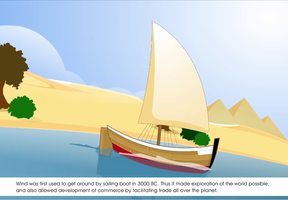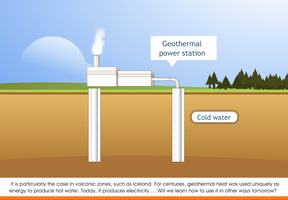Mechanical Energy 🔧
is energy stored in objects and is the sum of two other energy sources: and .
• Kinetic energy is motion. The faster an object moves, the higher its kinetic energy. The energy of rivers (hydraulic energy) and of the wind () is a form of kinetic energy. This energy can be converted into mechanical energy by water mills, windmills or pumps connected to turbines or into when it drives a generator.
• Potential energy is the energy stored in immobile objects and the energy of position. As its name indicates, it is a potential form of energy; in other words, it only manifests itself when converted into kinetic energy. For example, when a ball is lifted, it acquires potential energy (from gravity) that only becomes apparent when it falls.
Thermal Energy 🌡
Thermal energy is simply . It is caused by the movement of molecules and atoms within substances. Thermal energy therefore represents an object's internal kinetic energy.
In a steam engine or turbine, it is converted into mechanical energy; in a thermal plant, it is converted into electricity. Thermal energy contained in the subsurface ( energy) can be used for heating or to generate power.
Chemical Energy 🧪
Chemical energy is energy stored in the bonds of atoms and molecules. Some chemical reactions, known as exothermic reactions, can break these bonds to release their energy.
During combustion, which is an exothermic reaction, oil, gas, and convert their chemical energy into heat — and often light. In batteries, the electrochemical reactions that occur produce electricity.
Radiant Energy 💡
Radiant energy is energy carried by radiation. Both visible light and infrared radiation are forms of radiant energy. Both are emitted by the Sun and the filaments in electric light bulbs.
The energy of the Sun’s rays can be recovered and converted into electricity (photovoltaic energy) or heat (solar thermal power).
Nuclear Energy ⚡
is energy stored in the center of atoms, more specifically in the bonds between the particles (protons and neutrons) that make up the nucleus of an atom. When atomic nuclei are converted by nuclear reaction, heat is released.
In nuclear power plants, the nuclei are split in a process known as fission and some of the heat released is converted into electricity.
In stars like the Sun, atomic energy is released when the nuclei combine in a process known as fusion.
Electrical Energy 🔌
Electrical energy is the energy transferred from one system to another (or stored, in the case of electrostatic energy) using electricity, which is the movement of charged particles. To be precise, electricity is an rather than a type of energy in itself, but the term "electrical energy" is commonly used in everyday speech. Alternators and batteries are examples of systems that can provide electricity, while resistors, light bulbs and electric motors are examples of systems that receive electricity.


















